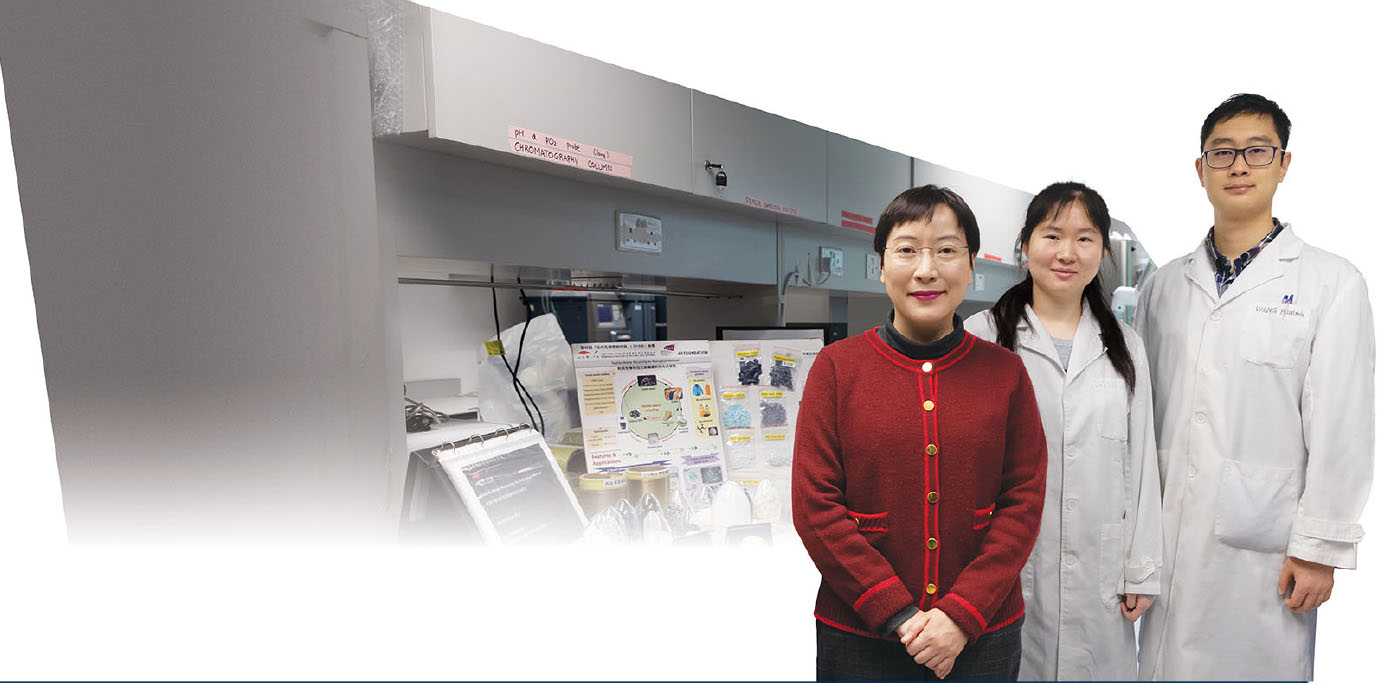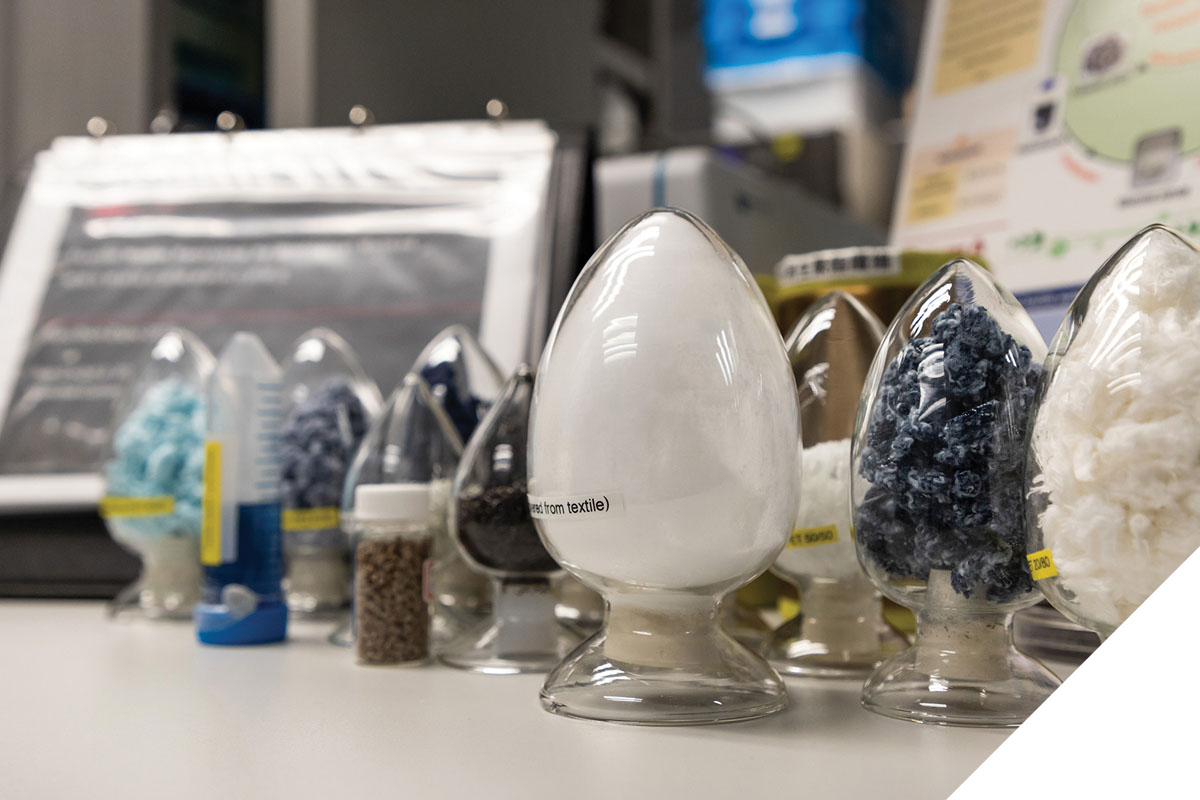Special Feature

Award-winning green technology revolutionises textile waste recycling
創新生物技術助紡織廢料重生
城大團隊透過創新生物科技研發,減少環境污染
|
 |
Hong Kong produces a staggering 800,000 tonnes of textile waste every year. Only a small amount of such textile, fashion and consumer waste is recycled. Most has been sent to landfills, creating another environmental headache, noted Dr Carol Lin Sze-ki, Associate Professor in CityU's School of Energy and Environment. “Hong Kong's current landfills will be full in a few years,” she said. “Thus we urgently need a sustainable recycling method for such waste.”
After four years of exploration, Dr Lin and her research team have now come up with a highly promising solution: Hong Kong's first green technology capable of recycling mixed textile waste and turn it into value-added materials such as glucose and synthetic fibres. The innovation won a Gold Medal at the 46th International Exhibition of Inventions of Geneva in 2018.
Novel approach
- Pre-treatment: modifying the structure of textile waste with reusable chemicals to reduce the amount of fibre.
- Enzyme production: cultivation of fungi on the textile waste for hydrolysis.
- Application of enzyme solution and hydrolysis: thoroughly blending the solution with pre-treated textile waste, then undergoing hydrolysis in a bioreactor to obtain soluble glucose.
- Conversion: The decomposed materials can be converted into different products. For example, polyester can be re-spun into polyester fibres for the textile industry while glucose can be converted into various bio-based substances, including bio-plastics and bio-chemicals.
International recognition
The research proved long and hard, and Dr Lin is keen to laud both her team's on-going endeavours and partner support over the years. “I really appreciate their effort and contribution in helping this project succeed,” she said. Dr Lin pays further tribute to CityU for providing her with brilliant and dedicated research students. “Enzymatic hydrolysis and microbial fermentation are taking place every second. To obtain an accurate production and growth chart, this meant three groups of researchers had to work shifts round the clock and perform non-stop observation – a really exhausting process,” Dr Lin noted.Given the scale and intensity of the research project, few in the city have tackled this area previously, with Dr Lin's biorefinery strategies becoming the first of their kind to be successfully developed in Hong Kong. “In the past, only Europe and the mainland conducted such research,” she explained. “Our technology often received praise from around the world when we shared our research results at international conferences. Now that our efforts have finally paid off, it makes all the hardships involved worthwhile.”
Sustainable recycling economy
Dr Lin herself is deeply committed to teaching and research, sometimes working seven days a week. Driving her on is a passion for her work and the dedication of team members. “It would be impossible to tackle all the tasks myself,” she said. “In addition, the enthusiasm of my researchers gives me the motivation and determination to keep pushing everyone forward.”With HKRITA securing more funding, the second stage of the study will be launched at the end of March 2019. In this phase, Dr Lin and her team will act as consultants. The aim is to ascertain how this home bred technology can contribute to the creation of a sustainable recycling economy for textile waste disposal around the world.

Dr Lin extracts a hydrolysed textile waste sample.
連博士示範抽取水解紡織廢料的樣本。
現今紡織廢料問題日趨嚴重,香港物質生活水平高,每年約產生80萬噸紡織廢料,其中只有少部分被回收利用,其餘則被送往堆填區,影響環境生態。城大能源及環境學院副教授連思琪博士十分關注此問題,她表示︰「香港目前使用的堆填區將於數年後飽和,故此我們迫切需要一種可持續的方法來處理紡織廢料。」
經過四年的研究,連博士與其團隊成功研發一項創新技術,可循環再用紡織廢料。這是香港首個以生物科技把紡織廢料轉為葡萄糖及合成纖維等增值產品的技術,這項技術更榮獲第46屆日內瓦國際發明展金獎。公眾均期望此創新科技能有助解決紡織廢料所造成的環境問題。
舊衣循環再造四步曲
連博士表示,這技術主要包含四個步驟。
- 紡織廢料預處理:利用可重覆使用的化學品改變紡織廢料的結構,將其體積減少。
- 培養真菌:在紡織廢料上培養真菌,從而產生可用作水解紡織廢料的纖維素酶。
- 進行酶水解:利用這些酶的溶液,與經過預先處理的紡織廢料在生物反應器中充分混合後水解,得出葡萄糖溶液。
- 產物資源化利用:分解出來的物質即可轉化成不同物料,例如聚酯纖維可再紡成合成紗線而用於紡織工業;葡萄糖溶液則可通過生物技術轉化為不同的生物產品,例如生物塑料和化學品等。
成功獲國際認同
連博士的團隊經過近四年日以繼夜的研究,付出的辛勞終於獲得成果。連博士感謝所有合作的夥伴和團隊成員︰「我非常感謝他們所付出的努力和貢獻,全因他們過去四年的支持,此項目才得到這理想成果。」她特別感謝城大給予她多位優秀的研究生,他們的付出以及彼此間的合作非常重要,她舉例說︰「酶水解和微生物發酵是24小時不停生長,要取得一個準確的生產和成長圖,需要三組研究員分別於24小時無間斷觀察的,過程的確很辛苦。」香港現時這一類的大型研究並不多,故是次成功研發的生物優化技術,屬於香港首創的獨有技術。連博士稱︰「以往只有歐洲和內地會就此方面進行研究,故近年每逢出席國際會議分享有關研究成果時,這項科研技術都獲得各國代表讚嘆。這都是大家努力付出的回報,就算多麼辛苦也是值得的。」
創造可持續循環經濟
連博士平日大部分時間都是教學和研究兼顧,她最忙的時候更是一星期七天不停工作。讓她忘記疲勞,堅持工作的不單是她對研究工作的熱誠,還為了她身邊團隊的全心付出。她說︰「只憑自己的想法並不足夠完成這些工作。是研究團隊的熱誠讓我有動力和決心,繼續推動大家一步步向前,最終取得成功。」香港紡織及成衣研發中心現已成功取得資金,將於2019年三月底開始進行第二期的研究計劃。連博士的團隊將會擔任此計劃的顧問角色,進一步將可循環再用紡織廢料技術擴充發展,期望能創造可持續的循環經濟,減少棄置紡織廢料所帶來的環境污染問題。



